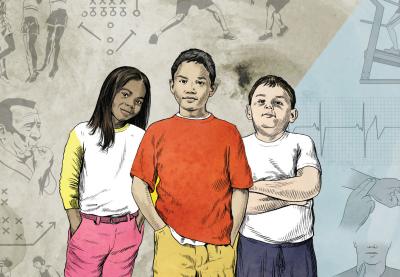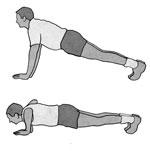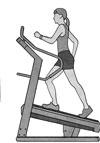“You might as well give me an ‘F’ now —get it out of the way. Then I’ll just go sit in the corner.”
Doris Dorr could hear the despondent defiance in Tim’s voice on the first day of physical education. The 10th-grader was “chubby,” not into sports and resigned to the humiliation he was sure awaited him in the locker room and gym.
Dorr, a veteran physical education teacher at Toppenish High School in Washington State, recognized his fears. But she asked her new student for a deal: Dress for every class and trust her to be a good teacher. “You can do this,” she told him. “Keep trying.”
Dorr taught Tim’s class five days a week, including 20 minutes in the classroom teaching about the connections between health, fitness and diet. Tim dressed every day and joined his classmates in compiling their personal fitness data. He took part in class: aerobic exercise, strength building, skill development and playing cooperative instead of competitive games.
Tim measured his progress using charts, graphs and a journal. He also noticed how supportive his teacher and classmates were of him and each other. Kids would finish their laps, then circle back and walk alongside him. They cheered when a classmate graduated from one push-up to five. “There’s only one way kids can get in serious trouble in my class,” Dorr says. “Only if they’re unkind.”
The sophomore shed 45 pounds during the semester.
“One day, I heard screaming from the other side of the gym,” Dorr recalls. “And there’s Tim with his arms above his head. He was shouting and the other kids were clapping and cheering. He had just taken his body weight and fat index and had reached his personal goal.”
But he wasn’t done yet.
Clichés of the Locker Room
Movies and TV shows often play up the harsh stereotypes of gym classes and school sports ruled by the law of the jungle, often for laughs. These clichés, sometimes deserved, portray a realm where jocks dominate and the timid or hopeless or bespectacled cower as far from the action as possible. The PE teacher, often a bewhistled person called “Coach,” tosses out balls of one shape or another, then walks off to strategize for Friday night’s game.
Even when real-world PE classes do not sink to that level, they can be intimidating places. As Doris Dorr’s discouraged student demonstrated, many students feel that flunking such a class carries less pain and shame than physical failure and taunting.
These unfortunate traditions may take a while to disappear from schools. But there is an up-and-coming generation of teachers and coaches like Dorr who are dedicated to inclusive practices. They are passionate about helping all kids discover the physical, social and emotional benefits— as well as pleasures—of physical activity.
The benefits are too great to forfeit, says Lynn Couturier. She is chair of the physical education department at the State University of New York, Cortland, and past president of the National Association of Sport and Physical Education (NASPE). “Physical education class might be the only activity some students get all day,” Couturier says. “It’s a huge loss if they do not develop the knowledge, skills and attitudes that can inspire them to be physically active throughout their lives.”
Banning Bullying
Reducing harassment in the locker room, gymnasium and on the playing field is also vital for creating a positive PE experience. Standards of behavior need to be communicated early and often, and bullying and slurs need to be confronted immediately and firmly, says Pat Griffin. Griffin, a former player and coach, is now head of the Changing the Game project, sponsored by the Gay, Lesbian and Straight Education Network (GLSEN).
“Nothing can turn a kid off faster to sports and PE than bullying and name calling,” Griffin says, noting that many LGBT teens—and those perceived as LGBT—cite the locker room as a place of sheer terror. “Teachers need to be vigilant, not disappear into their office when class or practice is over. Coaches also need to monitor their own behavior and language. They can be such important, powerful role models in schools. And what they say and do is more powerful than any Safe Zone sticker.”
In some instances, students are taking the lead in educating their elders. Craig Cassey, Jr., 18, is an out gay middle-distance runner from Media, Penn. At one high school track meet, he heard a coach he liked and respected make an anti-gay comment. “He was trying to pump up a teammate,” Cassey says.
Cassey had the courage to contact the coach afterward. “He felt awful, immediately apologized and promised to never do that again,” Cassey says. “It was a relief for me because he’s a fantastic coach. I wouldn’t love track this much or have medals from the state meet without him and what he taught me.”
Physical education class might be the only activity some students get all day. It's a huge loss if they do not develop the knowledge, skills and attitudes that can inspire them to be physically active throughout their lives.
Benefits vs. Budgets
The losses go beyond matters of fairness and personal development. They have a direct bearing on the nation’s physical and fiscal health. Diets featuring fast food, sugary soft drinks and declining physical activity have contributed to a tripling of childhood obesity rates in the United States in the last 30 years, according to the U.S. Centers for Disease Control. Today, nearly a third of American kids qualify as overweight or obese. Poor eating habits and sedentary childhoods have also contributed to more kids with asthma, heart problems and a spike in type 2 juvenile diabetes.
Some policymakers are looking to schools in general, and physical education in particular, to reverse this national trend. First Lady Michelle Obama has championed the “Let’s Move” initiative to raise awareness of childhood obesity while educating kids and communities about the advantages of healthier food and regular exercise. “Let’s Move In School” (which is unrelated to Let’s Move) is sponsored by the American Alliance for Health, Physical Education, Recreation, and Dance (AAHPERD). The program promotes physical activity throughout the school day by means of education, grants and professional development.
Even more than emphasizing the negative consequences of obesity, advocates of PE and sports programs seek to play up positive links between regular physical activity and overall well-being. Couturier and others cite a growing library of research that seems to confirm the obvious: Kids who regularly run, play and sweat demonstrate fewer behavioral problems, greater concentration and improved performances on standardized tests.
However, in many districts such long-term benefits are being undercut by short-term budget realities at the federal, state and local levels. Data on the national picture is hard to come by. But anecdotes about the impact of cuts abound. A Florida law mandating one semester of middle school PE each year is at risk of defunding as Gov. Rick Scott seeks to cut $2 billion from the state’s education budget. And last year in Toledo, Ohio, a $39 million shortfall meant the dismantling of all middle school and ninthgrade sports, as well as wrestling, cross-country and other team sports in high schools.
The federal No Child Left Behind law has prompted statehouses and school boards to emphasize the testing of core academics. So lawmakers across the country see cuts to physical education, sports and arts programs as changes that will trigger the least fuss. However, while wealthier communities will almost certainly fill the resulting voids through private means, that is less likely in communities with fewer resources.
Couturier says this trend is sadly shortsighted. “I understand that schools have to prepare children to become useful citizens,” she says. “But in the long run, there are few things more important than preparing our children to lead healthy lifestyles.”
You make your program so good, and the kids love it so much, people will throw a fit if they try to eliminate it.
Dealing With Size Bias ... And Students with Special Needs
In physical education, working with overweight children and teens can be a balancing act. Educators want to demonstrate support and acceptance for them exactly as they are, while at the same time offering resources and knowledge to help them—and all students—live healthier lives.
A consistent focus on individual progress and development can be key. Lesson plans that avoid explicit student-to-student comparisons of fitness and abilities can help overweight students feel safe enough to give their best efforts. Emphasizing improvements in what they can do and not what they look like or how much they weigh is essential.
In health class, teachers can guide all students in examining the connections between diet and fitness, why people eat what they eat and ways to eat healthier. Lessons can also explore how advertising and popular media twists people’s perception of body image and how opinions of the “ideal body” have changed throughout history.
Schools also need to make it easy for children to eat healthy foods. And they can create opportunities for kids to integrate nutrition and wellness into their daily lives. Likewise, it’s important for teachers and parents to model healthy behaviors to children. The most important thing is to show the importance of achieving optimal health—not focusing on appearance or thinness.
Special needs kids are one group that has sometimes been underserved by physical education classes. But in many districts, resourceful teachers are working to change that.
Sheryl Hall teaches PE in the Springfield Public Schools in Massachusetts. She works with PreK-1 children, including a class of students who are autistic that she sees for 40 minutes every school day.
Through experience and self-education, Hall has struck on a formula to reach children who are often viewed as the most difficult to reach: “Routine, routine, routine,” she says. “We start every class with a song, then some exercise, then another song. Then we walk or jog around the gym.” She signals students using handheld signs that indicate “stop,” “throw” and other instructions, an idea she gleaned from an expert on autism.
Hall also adapts skills exercises to help students experience success. To practice striking skills, kids will hit a ball off a tee then run the bases without the pressure of making an out. Students also kick a ball attached to a handheld band so the ball will not skitter away. “My goal is to create such a fun activity that they’ll want to continue,” Hall says.
In another class, Hall helped a student who is blind cross a low climbing wall by guiding her hand and foot placement. After repeated practice, the girl completed it solo. Hall then offered the class’s sighted kids the chance to wear a blindfold and do the same. They left the climbing wall with a new appreciation for their “special needs” classmate.
Upgrading PE Advocacy
NASPE and other advocacy groups recognize their programs are under the gun. In response, they are urging members to advocate for their curriculum by reaching out to every constituency—students, parents, fellow teachers, principals, school board members and lawmakers. NASPE has assembled an “Advocacy Toolkit” on their website with resources to help members communicate the story of why “quality physical education” matters. They also encourage PE teachers and coaches to apply for grants and forge community partnerships that can raise the profile and viability of their programs.
Doris Dorr sets out to prove the worth of what she does, kid by kid. Her classes are highly personalized, with students setting personal goals and assessing their own efforts and progress using target heart-rate monitors and other tools.
She also runs an after-school weight-loss program at Toppenish High, a school where 89 percent of students live below the poverty line. The young women, many who have endured neglect and abuse, often join weighing more than 300 pounds, Dorr says. But together with friends and classmates, they shed 70 pounds on average while gaining self-confidence. NASPE recently recognized her above-and-beyond efforts with its “Unsung Hero for Youth Award.”
“You make your program so good, and the kids love it so much, people will throw a fit if they try to eliminate it,” Dorr says, noting the support she gets from her colleagues, principal and district. “We have set up a curriculum that will benefit the kids, not just do what is easy.
“And we need to stop hiring coaches to teach physical education,” she insists. “We need teachers who look at their kids, and know they’re responsible for the well-being of all those kids.”
The Case for Inclusive PE
Couturier, a teacher of PE teachers, agrees that contemporary PE curricula need to emphasize health and fitness over competitive sports. One of the difficulties, she says, is that those who pursue physical education as a career often have a background of success in athletics. They don’t necessarily identify with challenges experienced by less-skilled and less-fit kids.
An increasing number of degree programs in physical education are trying to disabuse new teacher candidates of this old model. “We put them into school early on to expose them to the student population they will be working with, a minority of whom will have the same passion about sports as the teacher,” Couturier says. “We want [our teacher candidates] to practice adapting curricula so it includes and motivates as many kids as possible.”
Proponents of inclusive PE, including Dorr and Couturier, remain big fans of sports and competition. Most recognize their importance as a means for young athletes to practice discipline, hone physical skills and teamwork and strive for excellence, among other positive outcomes. But they see the mission and goals of athletics as distinct from those of inclusive physical education, where knowledge, effort and development should take priority over performance.
PE programs that value inclusiveness and refuse to give up on students also cannot help but improve a school’s climate. Exhibit A is Dorr’s reluctant sophomore, Tim. The semester after meeting his personal goals, Tim signed up for an elective PE class to continue exercising. One day, Dorr noticed he had wandered over from that other class and joined her students.
He was walking laps alongside the next “chubby kid.”
The Values of Inclusive PE
A survey of inclusive physical education programs reveals a culture of respect and community values. “It’s not just about fitness,” says veteran PE teacher Doris Dorr. “Our program is ingrained with character education.” Here are some ways to make a PE class more welcoming for all kids:
- Communicate clearly and firmly that encouragement and respect will be the fundamental value in PE classes, then model that support for less-capable students. A simple fist bump or pat on the shoulder can go a long way in helping a struggling student relax, feel safe and have fun.
- Personalize the curriculum as much as possible. Students should be developing their own fitness and skills, not competing against others. Competition, for the most part, should be reserved for sports programs.
- Research creative ways to accommodate special needs and physically less-capable students. Help all students recognize that physical education is about health, fitness and having fun, not necessarily doing everything by the rules.
- Emphasize effort and personal progress more than performance. One student may not be as fast as another, but a target heart-rate monitor may reveal he or she is exerting more effort and is making greater individual progress.
- Incorporate cooperative games in lieu of competition. For example, all students can contribute to a “Walk Across America” challenge in which they count up miles walked and run in a virtual cross-country journey.
- Whenever appropriate, link the PE curriculum to other school subjects. Creating a hybrid project with math, social studies and reading teachers helps students and colleagues value what you do in PE, and show you value what they do, as well.
- Refrain from using push-ups, laps or other physical activity as punishment. This practice sends the wrong message.
- All teachers should examine their own attitudes regarding size, race, religion, gender, sexuality, fitness and ability. They should strive not to let their own biases intrude on instruction or how they relate to students.





0 COMMENTS